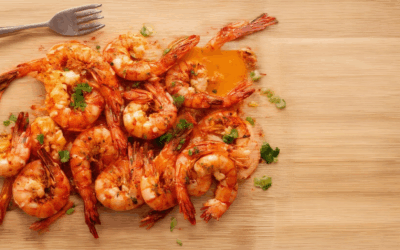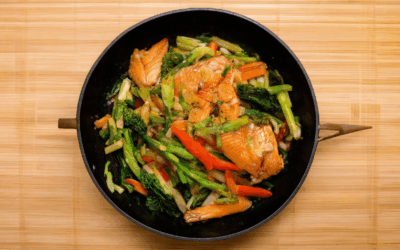Discover the perfect way to elevate your tilapia dishes with a carefully curated selection of spices and herbs. Whether you’re grilling, baking, or pan-frying, the right spices can transform a simple tilapia fillet into a flavorful delight. From classic herbs like garlic powder and paprika to more exotic options such as cumin and coriander, there’s a world of possibilities to enhance the natural taste of tilapia. Learn which spices pair best with tilapia, how to season for different cooking methods, and the secrets to creating a comprehensive spice blend that works across various recipes. This guide will walk you through the best practices for seasoning tilapia, ensuring your meals are both delicious and impressively well-seasoned.

Spices That Pair Well with Tilapia
Tilapia, known for its mild and slightly sweet flavor, can be enhanced with a variety of spices. Here’s a curated list of spices that complement tilapia fish:
- Paprika : Adds a smoky, slightly sweet flavor.
- Garlic Powder : Enhances the dish with a savory, earthy note.
- Onion Powder : Introduces a subtle sweetness and depth.
- Blackening Seasoning : Provides a bold and flavorful crust.
- Cilantro : A fresh herb that adds a herby touch, though technically a herb.
- Cumin : Offers a nutty flavor, particularly in Mexican-inspired dishes.
- Coriander : A versatile herb that pairs well with many fish.
- Cayenne Pepper : Adds a kick of heat for those who enjoy spicy dishes.
- Lemon Zest : Brightens the flavor with a citrusy tang.
- Oregano : Adds complexity with its herbal and slightly bitter notes.
- Thyme : Complements the dish with a pine-like aroma.
- Dill : A tangy herb that works well in seafood dishes.
These spices can be combined in various ways, such as in a rub, marinade, or sauce, to enhance the flavor of tilapia. Adjust the quantities based on your personal preference for Bold or Milder flavors.
Remember to season to taste and experiment with different combinations to find your perfect tilapia dish!
What Spices Go Well with Fish?
- Citrus: Lemon and lime zest/juice
- Aromatic Herbs: Garlic, shallots
- Common Herbs: Dill, parsley, cilantro
- Spices: Paprika, cumin, chili powder
- Specialty Herbs: Fennel seeds, mustard (Dijon)
- Asian Influences: Ginger, sesame oil
- Mediterranean Herbs: Oregano, thyme

Flavors That Pair Well with Tilapia
Tilapia is a versatile fish that can be flavored in numerous ways to create delicious meals. Here are some excellent flavor combinations that complement tilapia:
- Citrus Flavors: Lemon, lime, and orange zest add brightness and acidity, enhancing the natural flavor of tilapia.
- Herbs: Dill, parsley, basil, and fennel provide a fresh and aromatic touch, making the dish more vibrant.
- Spices: Chili peppers, cayenne, and smoked paprika add heat and depth, while coriander and cumin offer a herby note.
- Garlic and Olive Oil: A staple in many recipes, garlic and olive oil create a rich base for tilapia dishes.
- Other Flavor Enhancements: Mustard, capers, soy sauce, and teriyaki sauce add unique twists, such as tanginess or umami richness.
- International Influences: For a tropical feel, try coconut milk, while butter and white wine lend a French-inspired elegance.
These flavor combinations allow for creative variations, whether you prefer a simple preparation or an internationally inspired dish. Explore these options to find your perfect tilapia recipe!
For moretilapia recipes and flavor inspirations, visit our recipe collection .

What Makes Tilapia Taste Better?
Tilapia is a versatile and flavorful fish that can be elevated through thoughtful seasoning, cooking techniques, and complementary ingredients. Here are some expert tips to enhance the taste of tilapia:
1. Seasoning and Herb Combinations
Tilapia pairs exceptionally well with a variety of herbs and spices. A popular choice is a mix of lemon juice, garlic, lemon zest, and dill. This combination creates a bright, tangy flavor that complements the mild nature of tilapia.
2. Acidic Ingredients
Adding acidic ingredients like lemon or lime juice can brighten the flavor of tilapia. These acids help balance the richness of the fish and enhance its natural taste.
3. Spicy Enhancements
For those who enjoy heat, a sprinkle of cayenne pepper or a dash of hot sauce can add a bold kick to your tilapia dish. This spicy element contrasts nicely with the fish’s subtle flavor.
4. Fresh Herbs
Fresh herbs like parsley, cilantro, and dill are excellent additions. They add a refreshing aroma and a crisp texture to the dish, making it more vibrant and appealing.
5. Cooking Techniques
Grilling, baking, or pan-searing tilapia can bring out its best qualities. Searing the fish on a high heat creates a golden crust, adding depth and texture that many find irresistible.
6. Marinades
Marinating tilapia in a mixture of white wine, olive oil, and garlic can infuse it with a rich, savory flavor. This method ensures the fish remains moist and flavorful during cooking.
7. Pairing with Sides
Complement your tilapia with sides like roasted vegetables, quinoa, or a fresh green salad. These options enhance the overall meal without overpowering the star ingredient.
8. Healthy Cooking Tips
Avoid overcooking tilapia, as it can become dry and lose its flavor. Opt for medium rare or cook until it reaches an internal temperature of 145°F (63°C), checked with a food thermometer.
9. Type of Tilapia Matters
Different varieties of tilapia, such as Nile tilapia or blue tilapia, have slightly varying flavors. Choose the type that suits your preferred cooking method and taste preferences.
10. Regional Flavors
Culinary traditions around the world have influenced tilapia dishes. From Mexican ceviche to Asian stir-fries, experimenting with global flavors can introduce new dimensions to your tilapia dishes.
11. Freshness and Quality
Always use the freshest tilapia available for the best taste. High-quality fish will have a brighter flavor and a firmer texture, ensuring a satisfying dining experience.
By combining these techniques and ingredients, you can transform tilapia into a truly exceptional dish that delights your senses and impresses your guests.
- Try our Easy Baked Tilapia Recipe for a simple yet flavorful option.
- Check out our Grilled Tilapia Recipe for smoky, charred perfection.
- See our Pan-Seared Tilapia Recipe for a restaurant-quality dinner at home.
What to Put on Top of Tilapia?
To elevate your tilapia dish, try these flavorful topping and seasoning ideas:
Classic Lemon Garlic Butter Sauce
For a simple yet delicious option:
- Lemon Juice: A refreshing tanginess balances the richness of the butter
- Garlic Butter: Adds a creamy, aromatic touch
- Parsley: A fragrant herb that enhances the dish’s brightness
- Pepper: A sprinkle of black pepper for a hint of heat
Herb and Spice Enhancements
Experiment with these combinations for a burst of flavor:
- Dill: A herby note that pairs beautifully with fish
- Olive Oil: Infuses the dish with rich, Mediterranean flair
- Capers: Add a briny kick and texture
- Red Pepper Flakes: For a spicy twist
Alternative Toppings
Try these for a fresh and vibrant taste:
- Chives: A crisp, colorful addition
- Green Onions: A pungent and fresh element
- Lime Wedges: For a zesty finishing touch
- Basil Leaves: A sweet and earthy contrast
Cooking Methods
Depending on your preference, pair tilapia with:
- Grilled: Perfect for outdoor cooking sessions
- Baked: Ideal for family dinners
- Broiled: Quick and easy weekday meals
Optional Add-Ons
For an extra layer of flavor, consider:
- Crushed Almonds: A nutty crunch
- Capers: Tangy and satisfying
- Golden Raisins: Sweet and savory
- Sliced Bell Peppers: Color and crunch
Visit our Recipe Ideas section for more inspiration or check out our Herb and Spice Guide to pair perfectly with your tilapia.

Is It Better to Cook Tilapia in the Oven or Pan?
When deciding whether to cook tilapia in the oven or pan, several factors come into play:
- Oven Cooking:
- Healthier Option:** Baking tilapia can be a healthier choice as it typically requires less oil compared to pan frying.
- Consistency:** The oven provides steady heat, reducing the risk of the fish drying out.
- Flavor Retention:** Herbs and spices can be evenly infused during baking.
- Pan Cooking:
- Controlled Heat:** Stovetop cooking allows for precise temperature management, ideal for searing or sautéing.
- Crispy Skin:** Proper pan seasoning can result in a delicious crispy exterior.
- Convenience:** Faster cooking process, especially for those short on time.
Ultimately, the choice depends on personal preferences, dietary considerations, and cooking techniques. Both methods can yield excellent results, so it’s a matter of what suits your kitchen best!




0 Comments